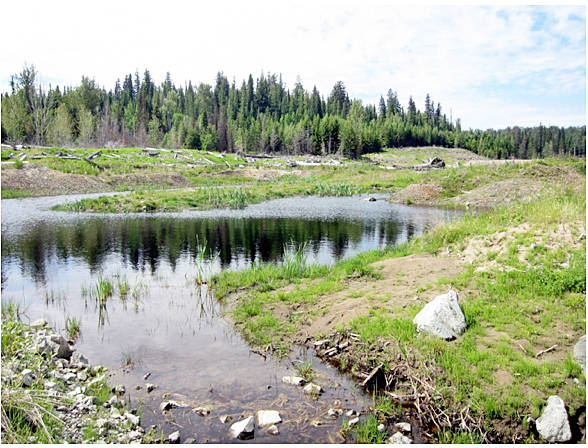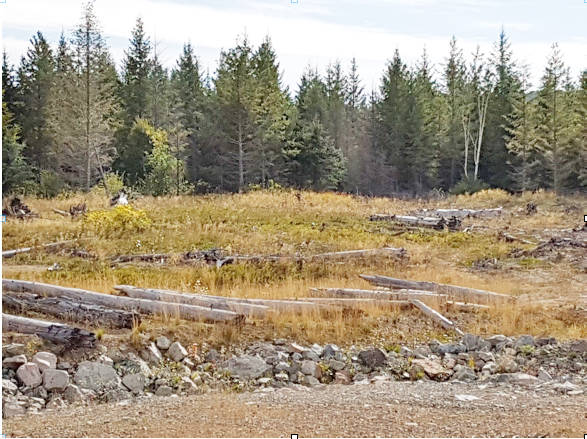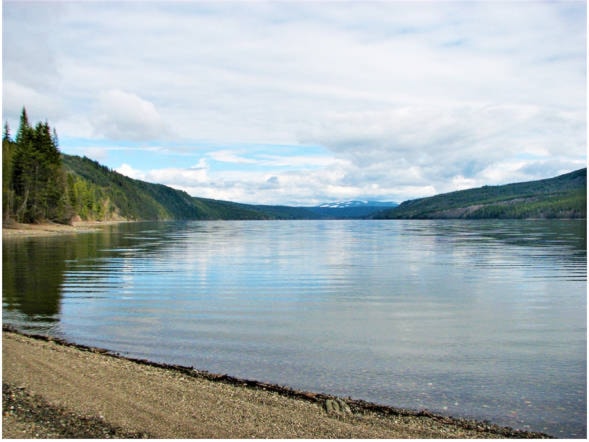Lyn Anglin
Mining Week 2018
Mount Polley continues to move forward with remediation of Hazeltine Creek after the tailings storage facility embankment failure in August 2014.
Much progress has been made on stabilizing and revegetating the creek corridor, with more than 300,000 native plants and shrubs planted over the last three years.
This summer, the mine plans to plant 300,000 conifers in the Hazeltine Creek corridor. A significant amount of natural revegetation has also been taking place.
Lots of coarse woody debris has been placed to contribute organic matter and small mammal habitat to the remediated areas, and mounding of soil has been done to encourage natural revegetation.
After a substantial amount of research by the mine and its consultants, and review of results and discussion with regulators and First Nations, the fish fence that has been keeping Polley Lake fish from entering upper Hazeltine Creek was removed last week.
This will allow the Polley Lake rainbow trout and other fish species to use the upper part of Hazeltine creek for spawning and rearing this spring and summer.
The water and the fish will be closely monitored to ensure that the conditions in the creek continue to be protective of aquatic life.
In addition, in case the spawning in Hazeltine Creek is less than hoped for, a streamside hatchery is being built to rear some rainbow trout under controlled conditions outside of the creek.
The conceptual remediation plan
Mount Polley Mine submitted its Conceptual Remediation Plan to the Ministry of Environment and Climate Change (ENV) on Jan. 31, 2018 for review and comment.
Several presentations were made to community groups prior to submission of the report.
The remediation of Hazeltine Creek has been underway for some time and the plan is to continue to repair the creek, revegetate the creek corridor, install fish habitat, and to return the area to productive habitat for fish and wildlife.
The mine engaged a number of consultants to look at options for remediating the two lakes affected by the TSF breach: Polley and Quesnel Lake.
The tailings that went into the lakes sank to the bottom very quickly. The tailings in Quesnel Lake, which is a very deep lake, are sitting at depths of greater than 100 metres and there is no evidence that they are re-suspending.
The mine’s water quality monitoring, plus some specialized research programs, indicate that metals are not leaching into the lake water, and natural sediments are now starting to cover the tailings.
Studies have also shown that the biological community that lives on the bottom of the lake is slowly recolonizing the area of the lake bottom that was covered by the mine tailings.
Options considered for remediating Quesnel and Polley Lakes include 1. Dredging out the tailings, 2. Adding organic material to increase the biological activity in the lake, or 3. Monitoring natural recovery.
After extensive analysis, the mine’s consultants have recommended that monitoring natural recovery is the best overall approach to return these systems to their natural state, while ensuring that no additional, unnecessary disruptions to the ecosystem takes place.
Quesnel Lake continues to look beautiful and the water quality meets all water quality guidelines. In fact, the water quality results in the west arm of Quesnel Lake where the tailings settled are essentially the same as areas of the rest of the lake.
Research results
Mount Polley has been very open to a number of research groups who wanted to do studies on the site after the breach.
A recent publication on the water quality impacts and creek system recovery done by a group from the UK concluded that there would now be a higher copper signature in sediments in Hazeltine Creek, but the contribution of copper to Quesnel Lake would be considered negligible.
Another recent paper looked at microbes collected in October 2014 from areas in and around Bootjack, Polley and Quesnel lakes, and in Hazeltine Creek.
Their results suggest that there has been some changes in the microbial community in areas highly impacted by the tailings breach, but they also concluded that many disturbed areas there was a surprising level of preservation of the microbial community at depth.
They also noted the prevalence microbiota that are to highly likely to naturally assist in the remediation mine-affected water at the site.
The mine is initiating some new research projects on constructed wetlands treatment systems for naturalized water treatment on the site. (This project was supposed to start last summer, but was delayed because of the Cariboo wildfires.)
The research will involve building a series of test wetland systems to determine how well the plants and microbiota on the site can treat the water, and if the water could be directly discharged to its natural watersheds.
Previous research work done on site, and the results of some of the recent research on the impacts of the tailings spill, give positive indications for these naturalized treatment systems. The mine is now in the process of preparing plans for these test systems and will be discussing these with the regulators at MEM and ENV.
Lyn Anglin is the chief scientific officer and vice president of environmental affairs for Imperial Metals.


